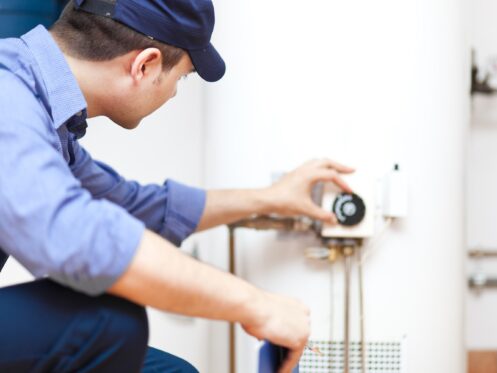More than 85% of residential properties in the U.S. have water with high levels of calcium and other substances. The general classification is that water is soft up to 60 milligrams per liter (mg/L). It’s moderately hard up to 120 mg/L, hard up to 180 mg/L, and very hard beyond that point. Homes with hard water can see a big drop in their water heater’s efficiency. This is important to note since water heating uses up 17% of the average household’s total energy.
Limescale
The U.S. Department of Energy (DOE) suggests water softening for many homes. This is due to the common issue of hard water and the problems it causes with limescale. Limescale is a hard and chalky deposit consisting of calcium carbonate. It forms when water evaporates, particularly when water is still or becomes heated. A water heater is often a perfect environment for scale because water is both heated and still. The DOE recommendation cites increased costs related to water heaters, but also:
- Pipes
- Fixtures
- Boilers
- Dishwashers
- Washing machines
Tanks
Scale can form inside a traditional water heater’s tank, occupying space the system would otherwise use to hold water. That can increase the pressure in the tank, leading to inefficient operation and loud, unusual noises. It can also prevent the heat from distributing throughout the water supply, which can cause the water heater to work harder.
Much of the scale can remain suspended in the water, leading to scale removal problems. It can also settle to the bottom of the tank and adhere to the tank walls. That buildup can cause different types of corrosion. This reduces efficiency and may harm the tank’s structural integrity.
Anode Rod
All municipal and well water systems have some minerals and metals in them. Tank water heaters have sacrificial anode rods to protect against those substances. Through electrolysis, the rod attracts those substances and limits how much gets into the tank. The term sacrificial refers to the rod’s corrosion due to this factor, which will lead to its eventual failure. If you have hard water, you will need to swap in a new anode rod more often. If your rod isn’t working well, it can cause inefficiency. This will also speed up the wear of components.
Pipes and Tubes
Scale can build up in the various pipes and tubes connected to your water heater, including the main pipes of your plumbing system. Although these scale layers are thin, their cumulative effect holds great significance. Each new layer reduces the potential throughput of the line. You may notice this from faucets and showerheads as reduced hot water pressure. It will also increase the workload on the water heater and make it use more energy.
Expansion Tank
Many modern plumbing codes call for expansion tanks for tank water heaters in closed plumbing systems. An expansion tank helps the water heater manage pressure. This prevents damage to pipes and other parts outside the unit. Scale buildup in water heaters can encroach on the home’s plumbing. If it reaches the tank, elevated pressure can cause damage to the tank, interior plumbing, and even the main water line.
Thermostats
Scale can build up on thermostats as well, and that insulation often leads to incorrect temperature readings. The thermostat can cause inefficient operation through suboptimal control. If it lowers your hot water temperature, you might want to raise the setting. But this will increase energy use even more.
Heating Elements and Heat Exchangers
Electric water heaters have two heating elements that are in direct contact with the water to transfer heat to it. Fuel-burning water heaters have heat exchangers, and some models have exchangers in direct contact with the water. Scale in the water can bind to elements and exchangers, acting like an insulator that inhibits heat exchange. The buildup also increases the deterioration of these components and causes reduced efficiency in that way. This is notable because it is often better to replace water heaters with bad elements and exchangers than to repair them.
Water Heater Maintenance
Even if you have soft water, it’s a good idea to schedule annual water maintenance. The maintenance required depends on the type of system you have.
Tank Water Heaters
Tank water heaters need regular flushing to remove all the sediment that can build up in the tank over time. All conventional water heaters have a drain valve. A plumber will attach a hose to that valve to drain all the water outside the home. In some cases, it may be necessary to sanitize the tank. A plumber will then refill the water heater and wait for it to reheat. It is also necessary to check the sacrificial anode rod and replace it as needed. A typical replacement timeframe is every three to five years.
Tankless Water Heaters
On-demand water heaters need periodic descaling. This is where a plumber uses a recirculating pump to cycle a cleaning solution through the system that removes scale. For routine maintenance, it’s common to use a mixture of vinegar and water. When descaling significant buildup, a plumber may need to use a chemical agent instead. Tankless water heaters also have air and water filters that need regular replacement.
Protecting Your Water Heater’s Efficiency
If you have moderately hard or hard water, maintenance alone may not be enough for your water heater. You may also find you’re having to schedule maintenance many times a year. You can protect water heaters from scale in two main ways: anti-scale devices and whole-house water softeners.
Anti-Scale Device
An anti-scale device is a local, appliance-specific hard water solution. You can use it in water heaters, dishwashers, and other appliances. They save money for homes with moderately hard water. Anti-scale devices often use template-assisted crystallization (TAC). This helps protect water heaters and other appliances. TAC changes the chemical structure of the calcium to make it less prone to forming calcium carbonate and leaving behind a residue.
Whole-House Water Softener
A whole-house water softener is the preferred way to protect a home’s plumbing in its entirety. It works right after the main water line. This protects all pipes, fixtures, and appliances. The DOE estimates that a water softener can pay for itself in most homes through reduced plumbing maintenance costs.
Most water softeners for the home are salt-based systems that use ion exchange to swap calcium for sodium chloride. These systems do need salt refills and have either one or two tanks. Single-tank systems have to go offline, generally during sleeping hours, to recharge. Dual-tank systems can continue operating while recharging.
Custom Hard Water Solutions in the Greater Tucson Area
Cal’s Plumbing is a plumbing company located in Tucson, AZ, and we have served Pima County and beyond for over 75 years. Our plumbers install and service all brands of both tank and tankless water heaters. We also install and service anti-scale devices and point-of-use water softeners. Also point-of-entry water softener systems.
Call today or contact us online to learn more about our products and services that can improve your water heater efficiency.






